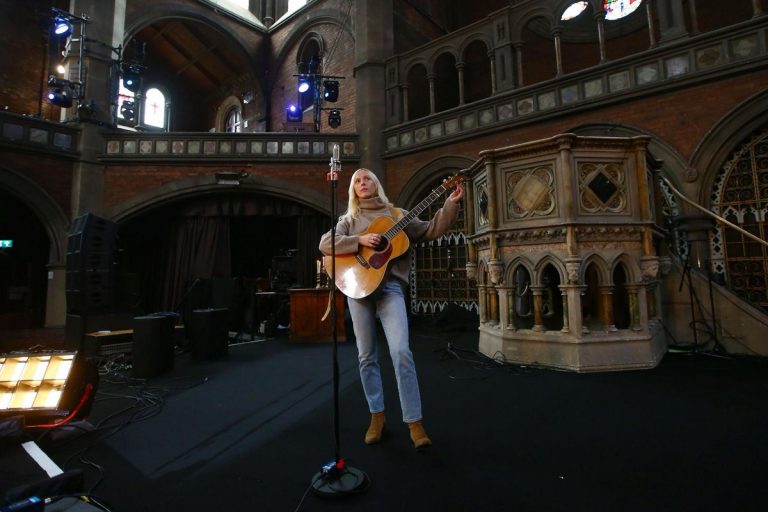Since social distancing guidelines effectively outlawed gigs in March, audiences and artists alike have been aching for a return to that special communal feeling they provide. So, it’s unsurprising that Laura Marling’s performance to a deserted Union Chapel in rainy North London was viewed by over 1000 remote ticket-buyers across Europe and the United States.
This was the second mainstream ticketed live streamed gig in the UK, following last month’s performance by Lewis Capaldi from his parents’ living room in Bathgate, Scotland. Where Capaldi’s stream had been self-shot in a domestic setting and featured plenty of casual chatter, Marling’s was stoic and had more production value, as it was shot by a couple of moving cameras and took place in a legendary venue. While consumers are likely to be split on which represents better value for their money (£5 for Capaldi’s, £12 for Marling’s, both including a charitable donation), these two events provide repeatable templates for the future, should this become a more utilised medium.
It will be a brave act who follows Laura Marling, though. She’s one of the few performers out there that has the ability to stand alone on a stage in a completely empty venue and project her voice not just to the back of the room, but out into the abodes of hundreds of remote viewers, without losing any of the immediacy.
Marling is already seasoned at this type of interaction, as she quickly adapted to the quarantine by filming ‘Isolation guitar tutorials’ from her home and sharing them with her fans on Facebook. Let’s also not forget the fact that, while the vast majority of artists delayed their album releases due to the pandemic, she bucked the trend and brought forward the release of her new album, Song For Our Daughter, so that people could enjoy it while locked down. It is therefore fitting that she should be one of the first artists to pioneer this sort-of new medium.
On the night, Marling’s only acknowledgement of the viewing audience was non-verbal, as she started the performance on the Union Chapel stage in the orthodox position, facing out into rows upon rows of empty pews. For the remainder she moved over to a second guitar-and-microphone set up that saw her facing away from the vacant audience, perhaps because it was less of a distraction, but more likely because it provided a more dramatic backdrop.
The skeleton crew manning the dual cameras did an exquisite job of keeping the visual element fluid without ever becoming invasive – although having such a dramatic setting undoubtedly helped. Marling, for her part, didn’t look down the camera at all, most often staring up into the heavens at the resplendent Union Chapel around her and sending each note into all of the historic building’s nooks and crannies.
The songwriter started her set with the grandiose sweep through the opening four songs of her 2013 album Once I Was An Eagle, collectively known as “The Suite”. The silence that followed this 15-minute masterclass was jarring – a feeling that never became normalised even by the end of the performance. It’s almost certain that the vast majority of viewers would have been compelled to clap from their sofas, mostly thanks to the iconic performance – but undoubtedly in some small part just to fill the awkward sonic void.
Marling opted not to speak between songs, which might have been a disappointment to some viewers who would have liked a word from their idol; something to make the connection between performer and audience a little more tangible, especially after months of separation from normal human contact. However, without the necessity to speak or wait for applause to die down, Marling was able to pack 17 songs into her hour-long set.
Instead of reaching out verbally or visually to her viewers, Marling channelled all the emotion she wanted to convey into her extraordinary performance. While expectedly drawing largely from Song For Our Daughter, the set also saw her stretching all the way back to her 2008 debut album, and playing songs from all but one of her seven records. It was an effective reminder of why she has been such a treasured part of the nation’s musical output for over a decade.
She seemed to use the cacophonous religious space around her to inflate some of these songs to new levels of grandiosity. She emphasised the bluesy undercurrent of “Wild Fire”, wringing out every emotive beat and leaving viewers hanging on every achingly pitched note in her voice. The snowy imagery of “Goodbye England” may not have seemed appropriate in June, but her performance converted it into a message of solidarity for a nation that has been stuck indoors for months – and Marling’s honeyed voice simultaneously thawed hundreds hearts that have long been in cold isolation, cut off from communal events.
It may not have been a replacement for ‘true’ live music, but after months without anything to fill the maw it was a much needed salve, and it’s highly unlikely that anyone would have logged off feeling short-changed. The performance reached such levels of transcendence that many doubters about the validity of ticketed live streams might be forced to re-consider their stance. Although, the combination of Laura Marling and the Union Chapel is a rather special one – being both an extraordinary performer and venue – setting the bar of expectation quite high for future forays into the medium.

